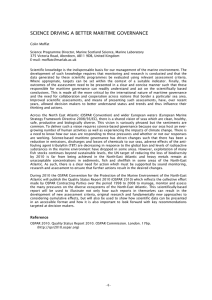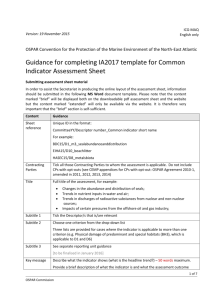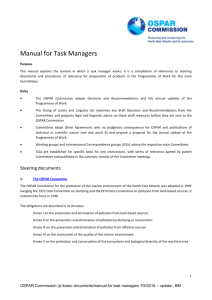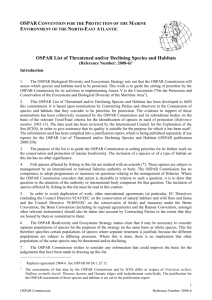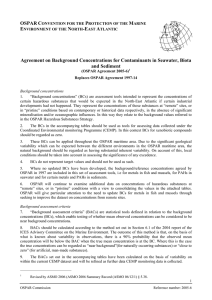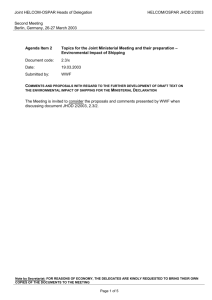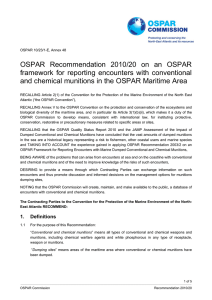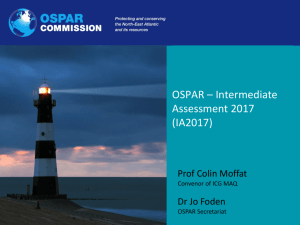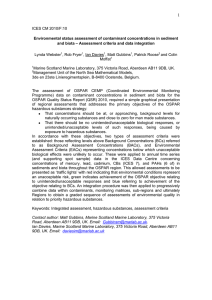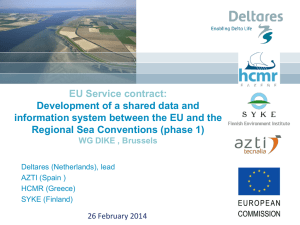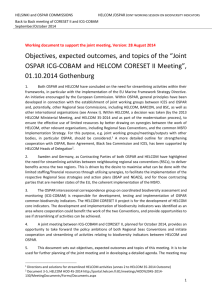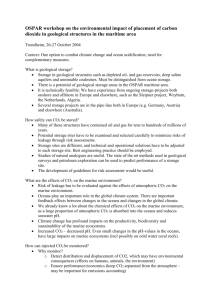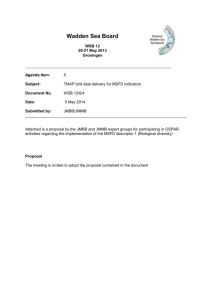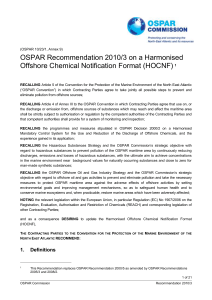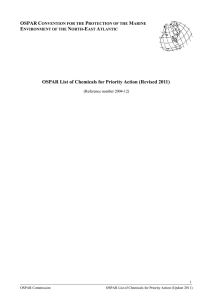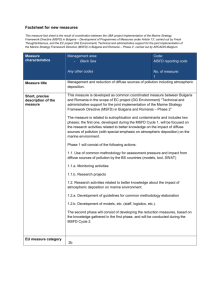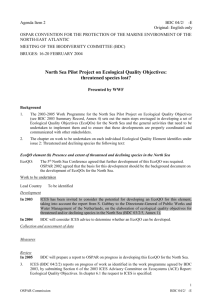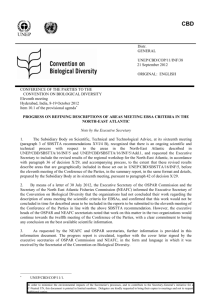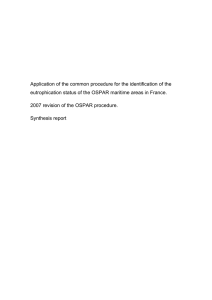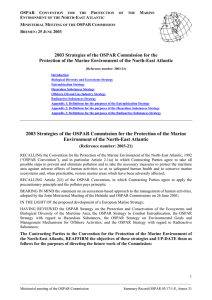What are the reporting units for?
advertisement
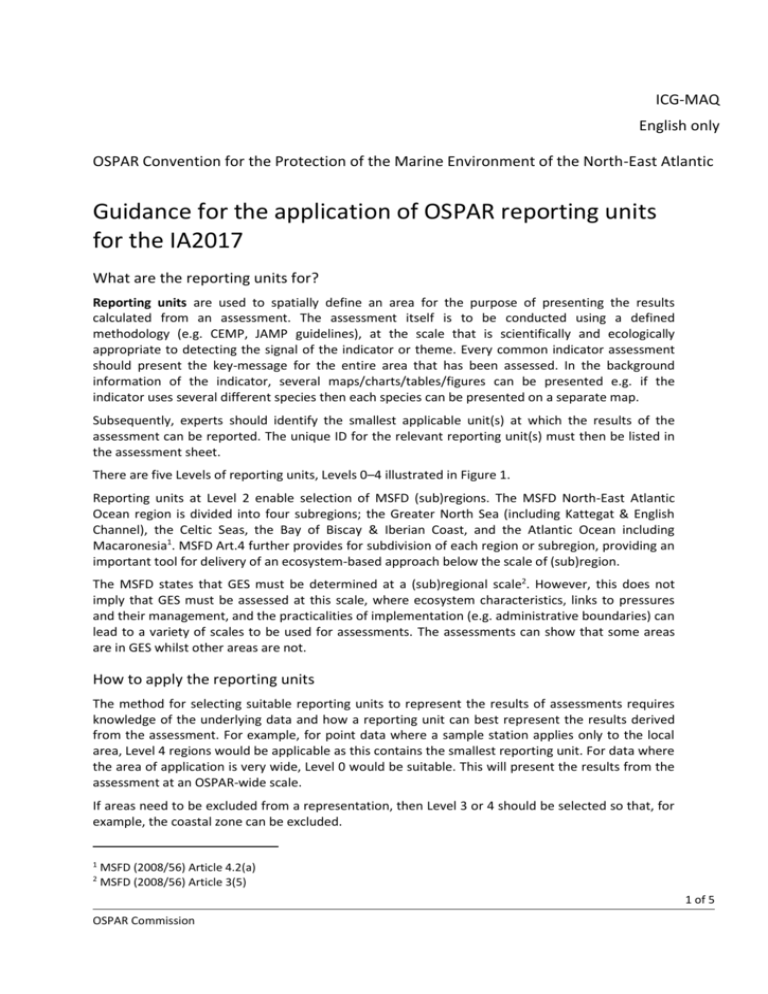
ICG-MAQ English only OSPAR Convention for the Protection of the Marine Environment of the North-East Atlantic Guidance for the application of OSPAR reporting units for the IA2017 What are the reporting units for? Reporting units are used to spatially define an area for the purpose of presenting the results calculated from an assessment. The assessment itself is to be conducted using a defined methodology (e.g. CEMP, JAMP guidelines), at the scale that is scientifically and ecologically appropriate to detecting the signal of the indicator or theme. Every common indicator assessment should present the key-message for the entire area that has been assessed. In the background information of the indicator, several maps/charts/tables/figures can be presented e.g. if the indicator uses several different species then each species can be presented on a separate map. Subsequently, experts should identify the smallest applicable unit(s) at which the results of the assessment can be reported. The unique ID for the relevant reporting unit(s) must then be listed in the assessment sheet. There are five Levels of reporting units, Levels 0–4 illustrated in Figure 1. Reporting units at Level 2 enable selection of MSFD (sub)regions. The MSFD North-East Atlantic Ocean region is divided into four subregions; the Greater North Sea (including Kattegat & English Channel), the Celtic Seas, the Bay of Biscay & Iberian Coast, and the Atlantic Ocean including Macaronesia1. MSFD Art.4 further provides for subdivision of each region or subregion, providing an important tool for delivery of an ecosystem-based approach below the scale of (sub)region. The MSFD states that GES must be determined at a (sub)regional scale2. However, this does not imply that GES must be assessed at this scale, where ecosystem characteristics, links to pressures and their management, and the practicalities of implementation (e.g. administrative boundaries) can lead to a variety of scales to be used for assessments. The assessments can show that some areas are in GES whilst other areas are not. How to apply the reporting units The method for selecting suitable reporting units to represent the results of assessments requires knowledge of the underlying data and how a reporting unit can best represent the results derived from the assessment. For example, for point data where a sample station applies only to the local area, Level 4 regions would be applicable as this contains the smallest reporting unit. For data where the area of application is very wide, Level 0 would be suitable. This will present the results from the assessment at an OSPAR-wide scale. If areas need to be excluded from a representation, then Level 3 or 4 should be selected so that, for example, the coastal zone can be excluded. 1 2 MSFD (2008/56) Article 4.2(a) MSFD (2008/56) Article 3(5) 1 of 5 OSPAR Commission (a) (b) (c) (d) (e) Figure 1: OSPAR Reporting Units; (a) Level 0 – OSPAR area, (b) Level 1 – OSPAR regions, (c) Level 2 – Subset of OSPAR regions, (d) Level 3 – Zone of coastal influence, and (e) Level 4 – WFD regions/amalgam of WFD regions 2 of 5 OSPAR Commission Naming structure of reporting units Following the spatial structure, OSPAR Reporting Units have a unique identifier (ID), using a nested approach. A unit ID begins with the corresponding Level number and the ID of the larger unit within which it is nested. The additional numbers in the ID represent the subdivisions of the larger unit. For example, see Table 1 with a visual representation shown in Figure 2. Table 1: Nested naming breakdown of OSPAR Reporting Units Unit Name Naming Breakdown L0 L0 L1.2 L1 2 L2.2.5 L2 2 5 L3.2.5.14 L3 2 5 14 L4.2.5.14.25 L4 2 5 14 25 3 of 5 OSPAR Commission Figure 2: OSPAR Reporting Units nested naming structure in practise Worked example Figure 3 is an example of an area that has been assessed for the common indicator PCB in sediment. Figure 3a illustrates the area of assessment for the indicator. Figure 3b illustrates the OSPAR reporting units that most closely correspond. 4 of 5 OSPAR Commission (a) (b) Figure 3: (a) area assessed for the common indicator PCBs in sediment, and (b) corresponding OSPAR reporting units The unique ID for each of the reporting units (in this case all of the units are from Level 3) should be supplied in the assessment sheet documentation. The list of reporting units below are the reporting unit IDs shown in Figure 3b. L3.2.2.1; L3.2.2.2; L3.2.3.6; L3.2.4.1; L3.2.4.2; L3.2.4.3; L3.2.5.1; L3.2.5.2; L3.2.5.3; L3.2.5.4; L3.2.5.5; L3.2.5.6; L3.2.5.7; L3.2.5.8; L3.2.5.9; L3.2.5.10; L3.2.5.11; L3.2.5.12; L3.2.5.13; L3.2.5.14; L3.2.5.15; L3.2.5.16; L3.2.5.17; L3.2.5.18; L3.2.5.19; L3.2.5.20; L3.2.5.21; L3.2.5.22; L3.2.5.23; L3.2.5.24; L3.2.5.25; L3.2.5.26; L3.2.5.27; L3.2.6.1; L3.3.2.1; L3.3.2.2; L3.3.2.3; L3.3.2.4; L3.3.2.5; L3.3.2.6; L3.3.2.7; L3.3.2.8; L3.3.2.9; L3.3.2.10; L3.3.2.11; L3.3.2.12; L3.3.2.13; L3.3.2.15; L3.3.2.16; L3.3.2.17; L3.3.2.18; L3.3.2.19; L3.3.2.20; L3.3.2.21; L3.3.2.22; L3.3.2.23; L3.3.2.24; L3.3.2.25; L3.3.2.26; L3.3.2.27; L3.3.2.28; L3.3.2.29; L3.3.2.30; L3.3.2.31; L3.3.2.32; L3.3.2.33; L3.3.2.34; L3.3.3.1; L3.3.3.2; L3.3.3.3; L3.3.3.4; L3.3.3.5; L3.3.3.6; L3.3.3.7; L3.3.3.8; L3.3.3.9; L3.3.3.10; L3.3.3.11; L3.3.3.12; L3.3.3.13; L3.3.3.14; L3.3.3.15; L3.3.3.16; L3.3.3.17; L3.3.3.19; L3.3.3.20; L3.3.3.21; L3.3.3.22; L3.3.3.23; L3.3.3.24; L3.3.3.25; L3.3.3.26; L3.3.3.27; L3.3.3.28; L3.3.3.29; L3.3.3.30; L3.3.3.31; L3.3.3.32; L3.3.3.33; L3.4.1.1; L3.4.1.2; L3.4.1.3; L3.4.1.4; L3.4.2.1; L3.2.7.8; L3.2.5.28; L3.2.5.29; L3.3.2.35; L3.3.3.34; L3.3.2.36; L3.2.7.10; L3.2.5.30; L3.2.5.31; L3.2.6.2; L3.3.3.35; L3.2.2.4; L3.2.2.5; L3.3.3.36; L3.2.4.4; L3.2.4.5; L3.3.3.18 5 of 5 OSPAR Commission
